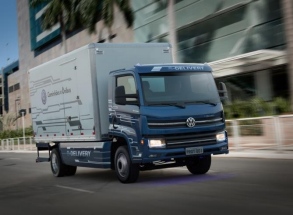
Volkswagen’s Caminhões e Ônibus e-Delivery is the first 100% electric truck of its category that has been fully developed in Brazil. With technology tailor-made for emerging countries, the e-Delivery satisfies global technology standards: the vehicle brings state-of-art solutions like smart systems to adjust battery demand depending on operations, and also recovers power from braking.
The eDelivery has up to 200km of autonomy, depending on the vehicle’s application and setting, and will be available in nine and 11-ton models, depending on clients’ needs.
The model meets demands for green logistics, zero emissions and circulation in low-noise places. Its’ powertrain was developed
in partnership with Eletra specially for use in commercial vehicles.
It is equipped with the new electric engine WEG AL160, which delivers 80kW (109hp) power, with maximum torque of 493Nm
and automatic transmission by Allison. It also features LiFePO4 lithium-ion battery banks – all this comes with zero emission and extremely low noise levels to improve comfort in urban delivery of goods.
There are two recharging options: quick, which is a 30% charge in only 15 minutes that can be performed several times along the vehicle’s route to increase its autonomy; and slow charging, which takes three hours to reach maximum charge.
The batteries in the plug-in concept vehicles are recharged by a standard CSS-standard external charger. The e-Delivery also features a 3-stage regenerative brake, which can be adjusted according to battery condition or driver’s preference. The regenerative brake is actuated before the pneumatic brake to slow down the vehicle, recovering up to 30%
of the power during braking and using the energy to recharge the batteries.
The vehicle also features the Eco-Drive Mode system, which reduces battery consumption depending on the battery condition, and adjusting the battery’s current demand according with the vehicle’s operation conditions. In addition to making batteries last longer, it means a longer service life for the braking system. All information on energy regeneration is available on the instrument panel, which, just as the interior design, follows the global standard for Volkswagen Group’s electric vehicles line.
Each detail of this project was designed to deliver a performance level superior to the solutions currently available on the market. The engine’s settings offer maximum torque even at low revolutions to optimize urban operations.
The powertrain is designed to pull off under load on gradients of up to 30% without any difficulty, aided by an Allison’s six-speed
automatic transmission.
Electric motors, independent from the drive engine, are responsible for the auxiliary systems such as air compressor, air conditioning, steering and water pumps, optimizing the main engine’s drive capacity. Shafts, suspension, chassis, wheels and tires follow traditional characteristics and inherit all the robustness of the new delivery line, sharing components in common with the platform.












More Stories
Sonatus – The industry is shifting gears to software
Cybord warns of dangers of the stability illusion
HERE building trust in ADAS systems